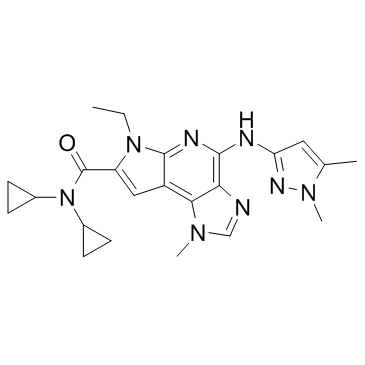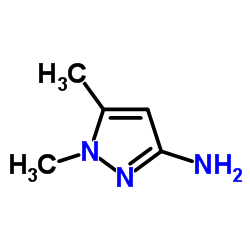1271022-90-2
| Name | N,N-dicyclopropyl-4-(1,5-dimethyl-1H-pyrazol-3-ylamino)-6-ethyl-1-methyl-1,6-dihydroimidazo[4,5-d]pyrrolo[2,3-b]pyridine-7-carboxamide |
|---|---|
| Synonyms |
Imidazo[4,5-d]pyrrolo[2,3-b]pyridine-7-carboxamide, N,N-dicyclopropyl-4-[(1,5-dimethyl-1H-pyrazol-3-yl)amino]-6-ethyl-1,6-dihydro-1-methyl-
N,N-Dicyclopropyl-4-[(1,5-dimethyl-1H-pyrazol-3-yl)amino]-6-ethyl-1-methyl-1,6-dihydroimidazo[4,5-d]pyrrolo[2,3-b]pyridine-7-carboxamide unii-7n03p021j8 BMS-911543 |
| Description | BMS-911543 is a selective JAK2 inhibitor, with IC50s of 1.1 nM, less selective at JAK1, JAK3 and TYK2 (IC50, 75, 360, 66 nM, respectively). |
|---|---|
| Related Catalog | |
| Target |
JAK2:1.1 nM (IC50) Tyk2:66 nM (IC50) JAK1:75 nM (IC50) JAK3:360 nM (IC50) |
| In Vitro | BMS-911543 is a selective JAK2 inhibitor, with IC50s of 1.1 nM, less selective at JAK1, JAK3 and TYK2 (IC50, 75, 360, 66 nM, respectively). BMS-911543 displays IC50 of >25 μM for all targets except PDE4 (IC50, 5.6 μM). BMS-911543 exhibits potent antiproliferative effect on the SET-2 and BaF3-V617F engineered cell lines (both dependent upon JAK2 pathway), with IC50s of 60 and 70 nM, respectively, and such an effect on SET-2 and BaF3-V617F cells is correlated with similar activity on constitutively active pSTAT5 (IC50, 80 and 65 nM, respectively)[1]. BMS-911543 (>20 μM) is cytotoxic to murine or human pancreatic ductal adenocarcinoma (PDAC) cell lines. BMS-911543 (5 and 10 μM) also blocks T regulatory cell differentiation in vitro[2]. |
| In Vivo | BMS-911543 is well tolerated up to 100 mg/kg in rats (mean AUC0-72 h, 11300 μM·h) and dogs (AUC0-24 h, 610 μM·h). A 15 mg/kg/day dose (Day 14 AUC0-24 h, 3200 μM·h) is well tolerated[1] in two-week repeat dose studies in rats. BMS-911543 (30 mg/kg, p.o.) suppresses the growth of tumor and prolongs the median survival in KPC-Brca1 mice. BMS-911543 also selectively reduces pSTAT5 expression in pancreatic tumors and decreases levels of intratumoral FoxP3+ T regulatory cells in mice administered BMS-911543[2]. |
| Cell Assay | Human and murine pancreatic ductal adenocarcinoma (PDAC) tumor cells or PSC are cultured in 96 well plates and the following day treated with BMS-911543 or DMSO vehicle control for 48 hours. After 48 hours, MTT reagent (ATCC) is added for 2 hours at 37°C. Samples are analyzed on a plate reader testing for absorbance at 450 nM[2]. |
| Animal Admin | Mice[2] Pancreatic tumors are confirmed in KPC-Brca1 mice by bioluminescent imaging (BLI) at 5-6 weeks of age. Briefly, mice are maintained on isofluorane anesthesia and imaged 10-15 minutes following intraperitoneal injection of Luciferin on a heated platform. Animals with a pancreatic mass of approximately 50-100 mm3 are randomized, and treatment is initiated the day following imaging. Mice are then treated for 2 weeks by daily oral gavage at a dose of 30 mg/kg BMS-911543. Following 2 weeks of treatment, animals are euthanized via CO2 asphyxiation followed by cardiac puncture. Plasma, splenocytes and tumor tissue are collected for further analysis. Pathology is assessed by H&E to determine differentiation state of the tissue as PanIN, papillary carcincoma or PDAC. For long term in vivo experiments, 8 week old KPC-Brca1 mice with advanced disease are continuously treated by oral gavage at 30 mg/kg of BMS-911543 until mice meet specified early removal criteria[2]. |
| References |
| Density | 1.5±0.1 g/cm3 |
|---|---|
| Boiling Point | 709.5±70.0 °C at 760 mmHg |
| Molecular Formula | C23H28N8O |
| Molecular Weight | 432.521 |
| Flash Point | 382.9±35.7 °C |
| Exact Mass | 432.238617 |
| PSA | 89.03000 |
| LogP | 1.42 |
| Vapour Pressure | 0.0±2.3 mmHg at 25°C |
| Index of Refraction | 1.788 |
| Storage condition | -20℃ |
| Precursor 6 | |
|---|---|
| DownStream 0 | |



![4,6-Dichloro-1-methyl-1H-imidazo[4,5-c]pyridine structure](https://image.chemsrc.com/caspic/040/887147-19-5.png)
![tert-butyl 6-amino-1-methyl-1H-imidazo[4,5-c]pyridin-4-yl(2,4-dimethoxybenzyl)carbamate structure](https://image.chemsrc.com/caspic/254/1271024-51-1.png)
![ethyl 4-(tert-butoxycarbonyl(2,4-dimethoxybenzyl)amino)-1-methyl-1,6-dihydroimidazo[4,5-d]pyrrolo[2,3-b]pyridine-7-carboxylate structure](https://image.chemsrc.com/caspic/026/1271024-57-7.png)
![4-(tert-butoxycarbonyl(2,4-dimethoxybenzyl)amino)-6-ethyl-1-methyl-1,6-dihydroimidazo[4,5-d]pyrrolo[2,3-b]pyridine-7-carboxylic acid structure](https://image.chemsrc.com/caspic/009/1271024-62-4.png)